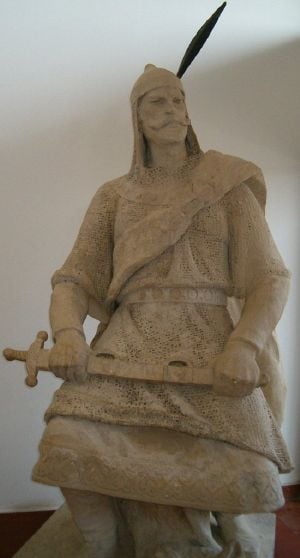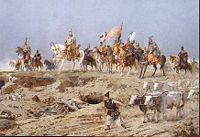Difference between revisions of "Árpád" - New World Encyclopedia
(credit Wiki) |
|||
| Line 1: | Line 1: | ||
| − | + | ||
[[Image:Nte-kir-arpad.jpg|thumb|Árpád]] | [[Image:Nte-kir-arpad.jpg|thumb|Árpád]] | ||
| − | '''Árpád''' (c. 845 – c. 907), the second [[Grand Prince of the Magyars]] (c. 895 – c. 907). Under his rule the [[ | + | '''Árpád''' (c. 845 – c. 907), the second [[Grand Prince of the Magyars]] (c. 895 – c. 907). Under his rule the [[Magyars|Magyar]] people settled in the [[Carpathian basin]]. The [[Árpád dynasty|dynasty descending from him]] ruled the Magyar tribes and later the [[Kingdom of Hungary]] until 1301. |
==His life== | ==His life== | ||
| Line 10: | Line 10: | ||
[[Image:Arpadfeszty.jpg|thumb|right|200px|Prince Árpád is crossing the Carpathians. A detail of [[Árpád Feszty]] and assistants' canvas (Ópusztaszer National Memorial Site, Hungary)]]. | [[Image:Arpadfeszty.jpg|thumb|right|200px|Prince Árpád is crossing the Carpathians. A detail of [[Árpád Feszty]] and assistants' canvas (Ópusztaszer National Memorial Site, Hungary)]]. | ||
| − | In the spring of next year, the Magyar tribes attacked the [[First Bulgarian Empire|Bulgarian Empire]] and defeated Emperor Simeon I, obliging him to conclude peace with the Byzantine Empire. Emperor Simeon, however, entered into an alliance with the [[Pechenegs]], who were the eastern neighbours of the Hungarian tribal federation, and he made an attack against the Magyar troops. In the [[Battle of Southern Buh]], Emperor Simeon I defeated their army; shortly afterwards, the Pechenegs attacked and pillaged their territories. The Magyar tribes were obliged to leave [[Hungarian prehistory|Etelköz]] and move to the [[Pannonian Basin|Carpathian Basin]] where they settled down ( | + | In the spring of next year, the Magyar tribes attacked the [[First Bulgarian Empire|Bulgarian Empire]] and defeated Emperor Simeon I, obliging him to conclude peace with the Byzantine Empire. Emperor Simeon, however, entered into an alliance with the [[Pechenegs]], who were the eastern neighbours of the Hungarian tribal federation, and he made an attack against the Magyar troops. In the [[Battle of Southern Buh]], Emperor Simeon I defeated their army; shortly afterwards, the Pechenegs attacked and pillaged their territories. The Magyar tribes were obliged to leave [[Hungarian prehistory|Etelköz]] and move to the [[Pannonian Basin|Carpathian Basin]] where they settled down (''Honfoglalás''). |
| − | The circumstances of Álmos' death are unclear. The leaders of the seven Hungarian tribes proclaimed Árpád to [[Grand Prince of the Magyars]] | + | The circumstances of Álmos' death are unclear. The leaders of the seven Hungarian tribes proclaimed Árpád to [[Grand Prince of the Magyars]] making him the first the hold this title; therefore Árpád is considered traditionally to lead the ''Honfoglalás'' ("the occupation of the country"). |
| − | [[Image:HetVezer-ChroniconPictum.jpg|thumb|Árpád and the six other chieftains of the Magyars. From the [[Chronicon Pictum]], | + | [[Image:HetVezer-ChroniconPictum.jpg|thumb|Árpád and the six other chieftains of the Magyars. From the [[Chronicon Pictum]], 1360.]] |
In 896 the Hungarian tribes occupied the Upper [[Tisza]] river, from there they undertook numerous looting raids in central and western Europe, and in 900/901 they moved to [[Pannonia]]<ref>It is remarkable that Árpád was never mentioned by contemporary Western sources, which strengthens the idea that he was the spiritual ruler of the Magyars.</ref>. The Magyars entering the Pannonian fields in 896 may have represented about 200,000–250,000 people. | In 896 the Hungarian tribes occupied the Upper [[Tisza]] river, from there they undertook numerous looting raids in central and western Europe, and in 900/901 they moved to [[Pannonia]]<ref>It is remarkable that Árpád was never mentioned by contemporary Western sources, which strengthens the idea that he was the spiritual ruler of the Magyars.</ref>. The Magyars entering the Pannonian fields in 896 may have represented about 200,000–250,000 people. | ||
| − | Based on Arabic sources, Árpád's title seems to have been ''[[kende]]''<ref>Some scholars consider Kende to be the name of a person.</ref> or ''[[gyula]]''. In that time ''kende'' was the spiritual leader of the Magyar tribes, while the ''gyula'' led their military campaigns. According to legends, Árpád hold the first "parliamentary" session with 40 other "nobles" on horseback before 900 | + | Based on Arabic sources, Árpád's title seems to have been ''[[kende]]''<ref>Some scholars consider Kende to be the name of a person.</ref> or ''[[gyula]]''. In that time ''kende'' was the spiritual leader of the Magyar tribes, while the ''gyula'' led their military campaigns. According to legends, Árpád hold the first "parliamentary" session with 40 other "nobles" on horseback before 900 C.E. |
==Children== | ==Children== | ||
| Line 27: | Line 27: | ||
==Legacy== | ==Legacy== | ||
| − | Although he is not considered the founder of the [[Kingdom of Hungary]] – that was his descendant [[Stephen I of Hungary|Stephen I]] –, he is generally thought of as the forefather of [[Hungarian people|Hungarians]] and is often affectionally mentioned as ''our father Árpád.'' Árpád was the founder of the [[Árpád dynasty|dynasty]] named after him, which would rule over the | + | Although he is not considered the founder of the [[Kingdom of Hungary]] – that was his descendant [[Stephen I of Hungary|Stephen I]] –, he is generally thought of as the forefather of [[Hungarian people|Hungarians]] and is often affectionally mentioned as ''our father Árpád.'' Árpád was the founder of the [[Árpád dynasty|dynasty]] named after him, which would rule over the kingdom of Hungary until 1301. |
| − | == | + | ==Notes== |
| − | + | {{reflist}} | |
| − | |||
| − | |||
| − | |||
==References== | ==References== | ||
| − | * [ | + | * Balázs, György, and Károly Szelényi. 1989. ''The Magyars: the birth of a European nation''. [Budapest]: Corvina.ISBN 9789631327106 |
| − | + | * Kosztolnyik, Z. J. 2002. ''Hungary under the early Árpáds, 890s to 1063''. East European monographs, no. 605. Boulder, CO: East European Monographs.ISBN 9780880335034 | |
| − | |||
| − | |||
| − | |||
| − | |||
| − | |||
| − | |||
| − | |||
| − | |||
| − | |||
| − | + | [[Category:History]]]] | |
| − | |||
| − | |||
| − | |||
| − | |||
| − | |||
| − | |||
| − | |||
| − | |||
| − | |||
| − | |||
| − | |||
| − | |||
| − | |||
| − | |||
| − | |||
| − | |||
| − | |||
| − | |||
| − | |||
| − | |||
| − | |||
| − | |||
| − | |||
| − | |||
| − | |||
| − | |||
| − | |||
| − | |||
| − | |||
| − | |||
| − | |||
| − | |||
| − | |||
| − | |||
| − | |||
| − | |||
| − | |||
| − | |||
{{Credit|216605386}} | {{Credit|216605386}} | ||
Revision as of 01:34, 14 July 2008
Árpád (c. 845 – c. 907), the second Grand Prince of the Magyars (c. 895 – c. 907). Under his rule the Magyar people settled in the Carpathian basin. The dynasty descending from him ruled the Magyar tribes and later the Kingdom of Hungary until 1301.
His life
Árpád was the son of Grand Prince Álmos, leader of the Hungarian tribal federation; his mother's name and descent is unknown. From the chronicles he was descanted of Attila the Hun his great-great-grandchild.
In 894, Árpád and Kurszán negotiated together with the representatives of the Byzantine emperor, Leo VI the Wise the terms under which the confederation of the Magyar tribes was willing to assist the Byzantine Empire against Emperor Simeon I of Bulgaria.
.
In the spring of next year, the Magyar tribes attacked the Bulgarian Empire and defeated Emperor Simeon I, obliging him to conclude peace with the Byzantine Empire. Emperor Simeon, however, entered into an alliance with the Pechenegs, who were the eastern neighbours of the Hungarian tribal federation, and he made an attack against the Magyar troops. In the Battle of Southern Buh, Emperor Simeon I defeated their army; shortly afterwards, the Pechenegs attacked and pillaged their territories. The Magyar tribes were obliged to leave Etelköz and move to the Carpathian Basin where they settled down (Honfoglalás).
The circumstances of Álmos' death are unclear. The leaders of the seven Hungarian tribes proclaimed Árpád to Grand Prince of the Magyars making him the first the hold this title; therefore Árpád is considered traditionally to lead the Honfoglalás ("the occupation of the country").
In 896 the Hungarian tribes occupied the Upper Tisza river, from there they undertook numerous looting raids in central and western Europe, and in 900/901 they moved to Pannonia[1]. The Magyars entering the Pannonian fields in 896 may have represented about 200,000–250,000 people.
Based on Arabic sources, Árpád's title seems to have been kende[2] or gyula. In that time kende was the spiritual leader of the Magyar tribes, while the gyula led their military campaigns. According to legends, Árpád hold the first "parliamentary" session with 40 other "nobles" on horseback before 900 C.E.
Children
- Levente
- Tarhos (Tarkacsu) (? – ?)
- Üllő (Jeleg or Jeleg) (? – ?)
- Jutocsa (Jutas) (? – ?)
- Zoltan of Hungary (947 – ?)
Legacy
Although he is not considered the founder of the Kingdom of Hungary – that was his descendant Stephen I –, he is generally thought of as the forefather of Hungarians and is often affectionally mentioned as our father Árpád. Árpád was the founder of the dynasty named after him, which would rule over the kingdom of Hungary until 1301.
Notes
ReferencesISBN links support NWE through referral fees
- Balázs, György, and Károly Szelényi. 1989. The Magyars: the birth of a European nation. [Budapest]: Corvina.ISBN 9789631327106
- Kosztolnyik, Z. J. 2002. Hungary under the early Árpáds, 890s to 1063. East European monographs, no. 605. Boulder, CO: East European Monographs.ISBN 9780880335034]]
Credits
New World Encyclopedia writers and editors rewrote and completed the Wikipedia article in accordance with New World Encyclopedia standards. This article abides by terms of the Creative Commons CC-by-sa 3.0 License (CC-by-sa), which may be used and disseminated with proper attribution. Credit is due under the terms of this license that can reference both the New World Encyclopedia contributors and the selfless volunteer contributors of the Wikimedia Foundation. To cite this article click here for a list of acceptable citing formats.The history of earlier contributions by wikipedians is accessible to researchers here:
The history of this article since it was imported to New World Encyclopedia:
Note: Some restrictions may apply to use of individual images which are separately licensed.

